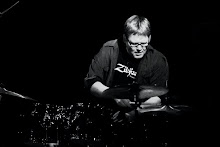There's some very exciting news as far as interviews go, so stay tuned....
Now on to our regularly scheduled trap'd.....
I always encourage drummers to not shy away from composition. I feel drummers have a unique perspective and often create unusual and original tunes. We can often feel intimidated by possibly knowing less about melody (and harmony) than some of our determinate pitch counterparts but I recently read an interview with Jack DeJohnette where he equates improvising beats and fills to composition. All we have to do as drummers is to apply the same principles to actual pitches. As usual, Mr. DeJohnette has linked everything together in his brilliant and Zen-like way. So using this free and open attitude, I'd like to share a few ideas about writing that have helped me a lot.
1. Just get started.
Don't worry that you have to write some glorious symphony, just write anything. At any instrument you choose (piano, guitar, voice, or even the drums) start playing with pitches.
When you get any sort of fragment that you like, write it down or record it.
2. Don't worry if you've heard the melody before.
If you find your melody is too close to something that's already done you can a) reverse the order of pitches, b) add pitches, c) subtract pitches, d) change the time signature, etc. You can try these techniques even if you don't think you're borrowing too much from another tune and they might set your melody off in a new direction. Don't be afraid to be playful and irreverent with your melodies.
3. Fool around with bass notes underneath your melody and voila, harmony is born.
If you find a top note (usually melody) and a bottom note (usually the root) the rest of the chord can usually be filled in from there. If you have trouble figuring this out, piano players guitarists you know can help you with this. Don't be shy! If a fellow musician wanted to ask you about rhythm, wouldn't you be happy to help him/her out?
4. You don't have to write your own set of chord changes.
A tried and true technique in jazz composition is the contrafact. That's just a fancy way of saying a new melody over an existing set of chords.
Try putting a melody on a simple blues.
The chords would be (each chord is one bar of 4/4 long)
F7 F7 F7 F7
B flat7 B flat7 F7 F7
C7 C7 F7 F7
(If you need help figuring out the notes in these chords, ask a piano playing friend, or you can look it up online).
The cool thing about a blues is it's usually grouped in 3 groups of 4 bars (like the way I have it set up above). Any even cooler thing about the blues is that if you write a nice catchy 4 bar riff, it will fit over the other 8 bars as well.
So all you have to write is 4 bars, and the harmony is provided for you. That's not so hard, is it?
I'll close with a great example of a "riff style" composition like I was describing above.
This is "C Jam Blues". (Note that the little solo breaks the musicians take are an extra 4 bars, and the form starts on the solos once the rhythm section kicks in.)

No comments:
Post a Comment